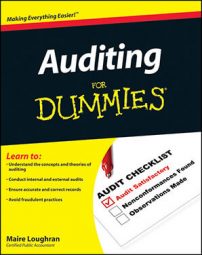When you are auditing stockholder equity, you want to look at the capital stock accounts. Capital stock includes all paid-in capital. The board of directors has to approve all capital stock transactions, including the type of stock issued, the total number of shares that can be outstanding at any one time, and the declaration of dividends.
During your audit of capital stock accounts, your two priorities are to verify the issuance of stock and to check the repurchase of stock.
Verifying the issuance of stock: Confirming the issuance of stock is your first priority when reviewing capital stock accounts. To do so, start with the corporate kit. When a business incorporates, it usually throws together a corporate kit. In addition to items tailored to the individual business, the kit may include the corporate charter, minutes of the shareholder and board of director meetings, benefit plan documentation, the stock register, and the stock certificate book.
The stock register lists shareholder contact information, the amount of shares that each shareholder owns, and the identifying number of each share held by the investor. The stock certificate book contains all nonissued and cancelled stock certificates. Cancelled certificates are those that have been sold by the purchaser to another buyer.
Here are some common audit techniques to verify the issuance of stock:
Make sure any unissued stock certificates per the stock register are present and accounted for in the stock certificate book.
Trace shares of stock issued per the stock register to the stock certificate book to make sure they have indeed been issued.
Compare the number of shares outstanding per the stock register to the description on the financial statements.
Many companies no longer issue paper stock certificates.
Checking the repurchase of treasury stock: If your audit client has repurchased shares of its own stock, the treasury stock’s cost and number of shares repurchased have to be shown on the balance sheet as a reduction to stockholders’ equity. Your client has the option of cancelling the treasury stock, reissuing it, or holding it indefinitely.
Cancellation involves defacing the stock certificate in some way. For example, a company may punch holes in the certificate, draw a big X across the face of it in black or red ink, or rubber-stamp it as “cancelled.”

